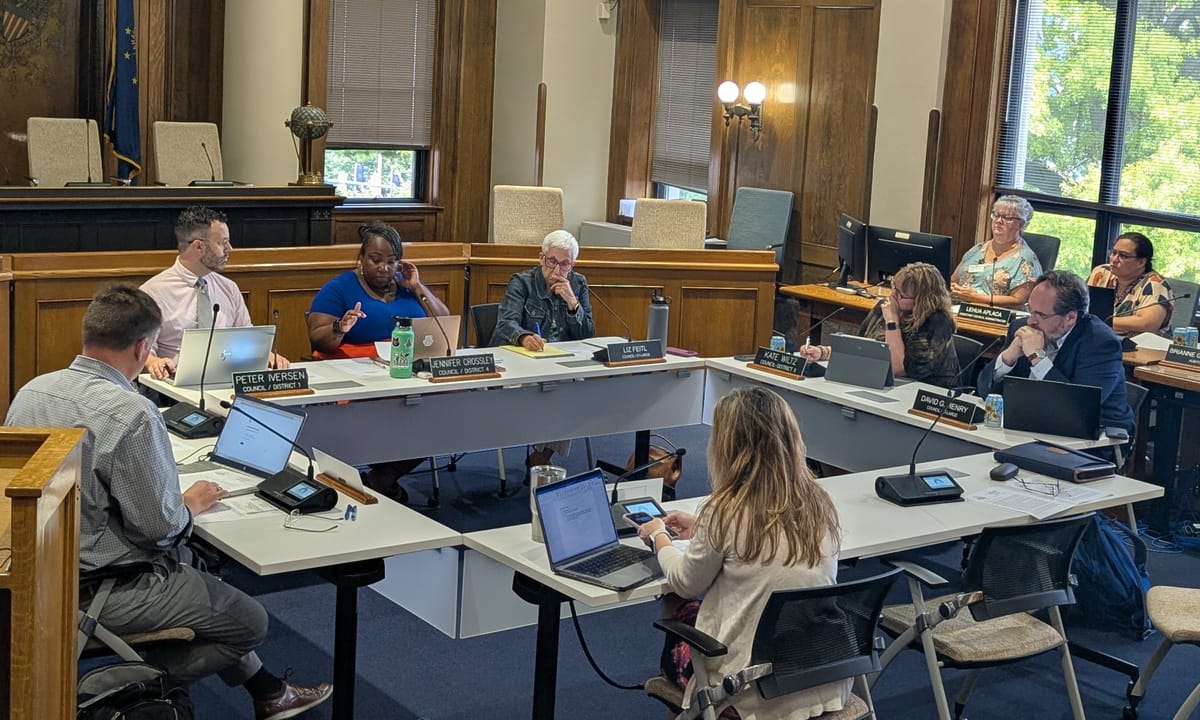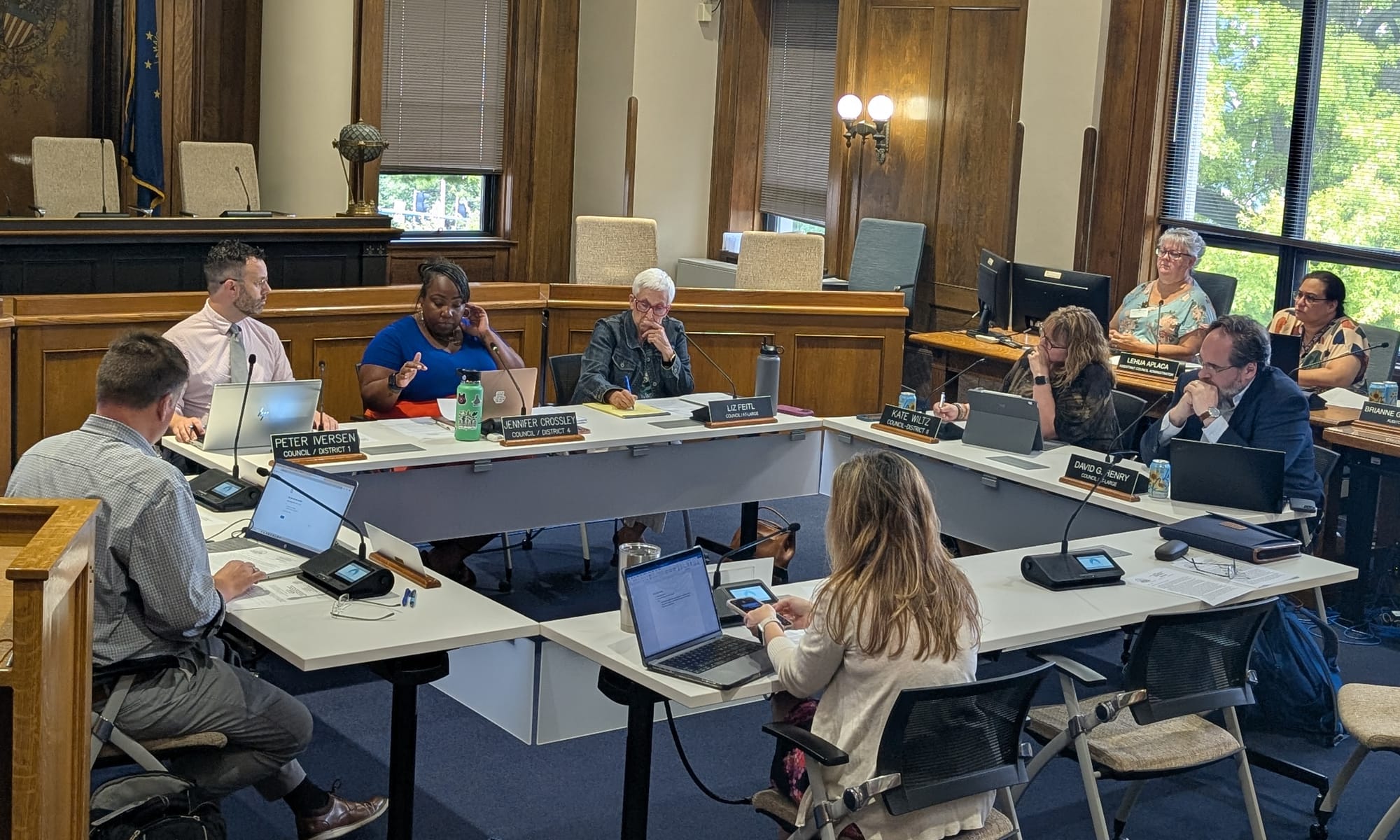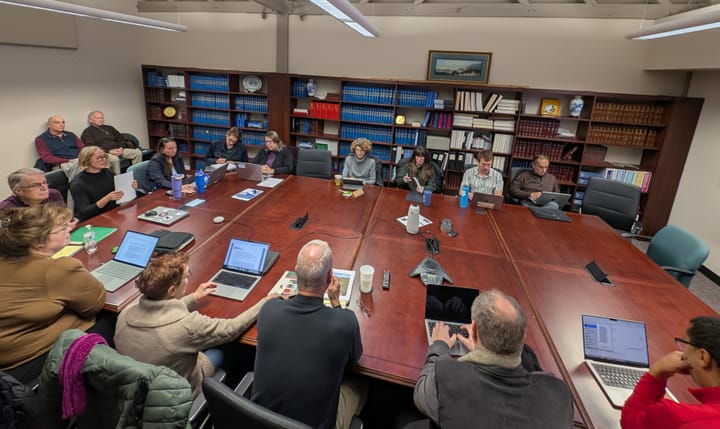Jail plan update: Monroe County scraps letter to lawmakers, shifts focus to reducing project budget
At a joint meeting of Monroe County councilors and commissioners on Friday, the elected officials decided not to send a letter to state legislators about the county’s planned new jail. They agreed to focus their efforts on how to move the project forward within the constraints of a reduced budget.


At a joint meeting of Monroe County councilors and commissioners on Friday (Aug. 8), the elected officials decided not to send a letter to the state legislature about the county’s planned jail and justice center project. Instead, they agreed to focus their efforts on how to move the project forward within the constraints of a reduced budget.
Discussions about the content and purpose of the letter had started around the end of June. The letter was originally intended to address obstacles posed by recent legislative changes (SEA 1), especially those affecting the county’s bonding capacity for the project. The jail and colocated justice center project has a working budget of $225 million, which has increased as the design work has progressed, as officials have worked behind the scenes to make design changes to bring costs back in line.
The idea had been to ask the state legislature to amend SEA 1 to help Monroe County fund the new jail project.
However, as councilor David Henry put it: “My impression is that at this point, a letter that goes into great depth asking for the changes in SEA 1 … would not be read or received by anybody at Ways and Means [Committee], or at least our own delegation … for some time.” For Henry, that meant there is not an urgent need to send a letter.
Commissioner Jody Madeira said she was fine “pulling the letter,” which is to say not sending it. Commissioner Julie Thomas, attending through remote connection, confirmed Madeira’s view: “I think it’s fine to pull this letter. We’ve got conversations we’re going to have with various legislators either way.”
Thomas continued, “I don’t want to spend time editing a letter that nobody wants to send. She added, “Let’s not send it. Let’s just move on to the next agenda item.”
Why a bigger jail?
With the letter set aside, council president Jennifer Crossley turned the meeting to the practical challenges of the jail project, especially in light of a tighter budget for the project. The current size of the jail population was a key point of discussion.
Chief deputy sheriff Phil Parker reported to the group: “As of today, our total jail count was 259. Our secure bed count is 224 now—so we’re still below the 244 limit.”
The limit of 244 stems from the threshold specified in the settlement agreement with the ACLU, which filed suit in 2008 over the crowded conditions at the jail. The Monroe County jail still operates under the terms of the settlement agreement, which has been extended several times. The settlement agreement is the impetus behind the county’s new jail project. [Monroe County jail timeline]
Parker continued his remarks about the jail population by putting the numbers in the context of the period since Monroe County sheriff Ruben Marté took office at the start of 2023. “Over the past two years or so, we’ve been somewhere in the jail total count between 220, 230 pretty consistently,” Parker said. He added, “In the last four to six months, that has started to climb and continues to climb. For example, in July, our total bed count was over 240 15 times. We track it daily. The average for July was 239 so here we are. We’re creeping up.”
The reason for the uptick in the current jail population got some discussion around the table, as well as from the public mic at the end of the meeting. Councilor Peter Iversen highlighted the ongoing challenge of addressing substance use disorder among the county’s jail population. Iversen called it a “pernicious problem.” He added, “If you just look at the arrest records, methamphetamine possession shows up over and over and over again.
A B Square search of the most recent 284 daily jail book-in reports turned up “methamphetamine” among the charges for a given day in 113 of the daily reports. Of the 284 reports, 51 included at least one prisoner who was booked in on charges that included possessing a syringe.
Councilor Jennifer Crossley also pointed to the reasons that people are getting booked into the jail: “These people that are getting rounded up for various crimes, possession, … failure to appear, contempt, all of those things.”
During public comment, Monroe County resident Seth Mutchler echoed the call for a broader approach. About the rise in the numbers for the current jail population, Mutchler said, “I don’t think it’s a given that they will just continue to rise year over year,” adding, “I think that they can go down, and there are ways that we can make it go down.”
Mutchler alluded to a recent series of arrests announced by the city of Bloomington police: “It would help, maybe, if the city was not rounding people up and doing raids in Seminary Square Park and installing Flock surveillance cameras in our downtown …” Mutchler echoed Iversen’s call for a focus on treatment.
Scope of project: Just jail or justice center, too?
The settlement agreement with the ACLU is focused just on the jail, not the justice center, which includes the courts, prosecutor’s office, public defender’s office, clerk’s office, and the sheriff’s office, among others. Based on Friday’s deliberations, there’s at least some interest among county councilors in getting a cost comparison between the justice center alternative that is currently being pursued, and one that is far more limited in scope, which would include just a couple of courtrooms in addition to a jail.
County attorney Jeff Cockerill was asked to comment on the scope of the project in connection with the terms of the purchase agreement for North Park as a location for the planned new justice center. The county has not yet closed on that deal.
Cockerill said, “In the purchase agreement with the county and the developer—that was approved by the commissioners and approved by the county council—it says that the use of the jail will not occur until there are at least bids out for the construction of courts. It does not specify all of them.” Cockerill added, “It does not specify any of the other departments or anything like that—it’s simply courtrooms, is what is referenced in that agreement.”
Commissioner Jody Madeira stressed the fact that even if the settlement agreement with the ACLU addresses only the jail, the entire building at 7th Street and College Avenue is problematic. She put it like this: “Our building is sick. In addition to just this ACLU mandate, we should care about this issue because we, frankly, have county residents that spend a great deal of time in this building, not just inmates, but staff members.” Madeira continued, “The sickness is affecting not only our inmates but our correctional staff, our guards, our judges, our prosecutors staff, and frankly, I’m concerned about all of these people, and our solution needs to address all of this comprehensively.”
Madeira gave a graphic description of conditions inside the current justice building as a counter to the argument that the current building could be rehabbed, as an alternative to constructing a new building. “We have staff members who report leaks. We have staff members who have to cover up their computers at the end of every day with plastic so that their equipment does not get damaged. We have judges who have to work with buckets on their desks. We have judges who have had sewage come down onto their offices, in their offices, onto their computers,” Madeira said.
Madeira described how there were people who were working in 80F° offices in June. Madeira called the current justice center a “dangerous building,” saying, “We need to leave that building behind, and we need to leave that argument behind as a community, and we need to move forward together.”
Next steps: Revision to project design?
The design/build consultant for the project is DLZ Corporation. WGS is construction manager for the project. The letters in the acronym come from three different construction companies who are working as a kind of joint venture–Weddle Bros. Building Group, Garmong Construction, and Smoot Construction.
In February, when the estimated cost of $237 million was presented publicly, it was already bigger than the working budget of $225 million that county officials had settled on. Based on the timeline presented in February, there was supposed to be a meeting on May 29 for presentation of schematic design and new cost estimates. But after February, cost estimates had already risen to between $260 million and $280 million. The May 29 meeting never happened.
On Friday, Madeira wanted county attorney Jeff Cockerill to explain how decisions had been made since February about revisions to the project design in an effort to bring costs back in line. Madeira said, “I think the public might assume that we’re all in the room at all times when decisions are being made on the jail design, and we’re not. We can’t be because of Open Door laws.”
Cockerill described how he and the administrator for the commissioners, Angie Purdie, had worked with the different departments to go over those suggestions for design revisions to save costs.
Cockrill said, “It’s really a lot of a tug of war where departments naturally are going to advocate for their departments because they believe in their missions and they want to do the best job they possibly can.” Cockerill said in February the estimate was around $237 million and then grew to more like $260 million or $270 million. Cockerill said he had told DLZ and WGS, “We’re not going to have another meeting with that until we are at least in a ballpark of what we can afford. And so that’s kind of why it’s taking so long.”
Council president Crossley said at Friday’s meeting that Aug. 19 was being considered for a jail schematic design update. She added that such an update was overdue, noting the last time the council received one was in February.
“I think it’s time for everybody to come to the table and hear those updates,” Crossley said.
Cockerill said the update had not yet been scheduled, but the information should be available for a presentation by Aug. 19.




Comments ()